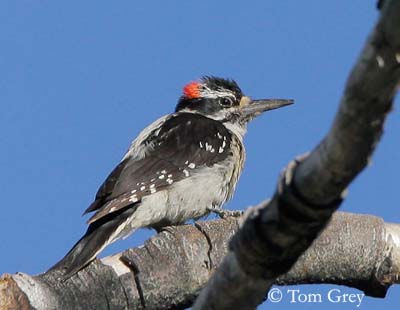
Hairy Woodpecker
Picoides villosus
Piciforme Order – Picidae Family
BIOMETRICS:
Length: 18 à 26 cm
Wingspan: 33 à 41 cm
Weight: 40 à 95 g
LONGEVITY: Up to 15 years
DESCRIPTION:
Hairy Woodpecker is a medium-sized black and white woodpecker.

It has black head, with broad white supercilium and malar stripe extending to the rear neck. It has black moustache and nape. Back is white and rump is black. Wings are black with white spotting. Underparts are white. Tail is black, with white outer feathers.
Adult male has red patch on the rear crown. It has greyish bill, nearly as long as head. Eyes are reddish brown. Legs and feet are greyish or tinged blue.
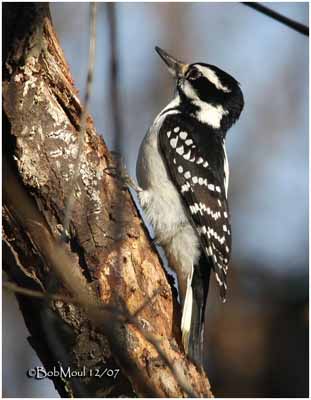
Female has black patch on the rear of the head. She is slightly smaller than male.
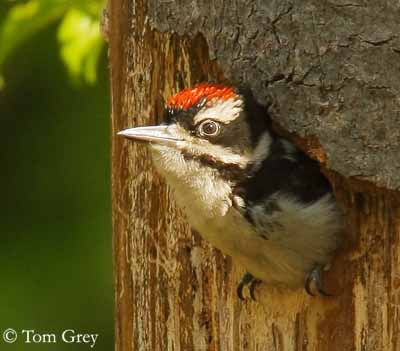
Juvenile male has red forehead, but lacks the red patch at the rear of the crown.
Juvenile female is similar, but lacks the red.
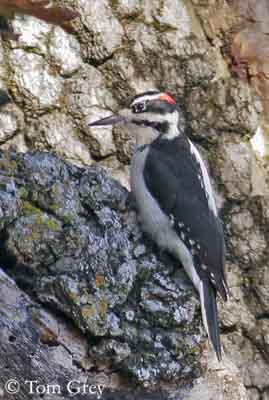
VOICE: SOUNDS BY XENO-CANTO
Hairy Woodpecker’s calls include a loud and sharp “peek”, and a harsh rattle. When is disturbed, it utters a “brrrup” noise. When agitated, its call is a slurred and stuttering “peek-rr-krr”. Its drumming is very fast and buzzy.
HABITAT:
Hairy Woodpecker is fairly common. It lives in both open and dense forests with dead trees. It also frequents gardens, parks and residential areas. But it can be found from sea level to high in the mountains.
RANGE:
Hairy Woodpecker is resident from Central Alaska to Newfoundland, and southward, to Florida and Central America, and also in the Bahamas.
BEHAVIOUR:
Hairy Woodpecker can hear wood-boring insects munching on the wood, and it may feel vibrations made by them, moving in the wood.
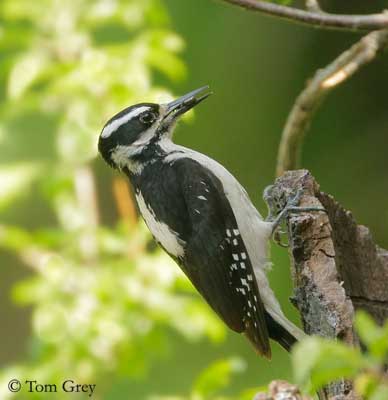
It forages on trees, bushes, and other kind of vegetation, but also on dead branches on the ground. It taps, probes and pries at the bark, and sometimes, it excavates deep into the bark, to get the hidden insects.
When Hairy Woodpecker is disturbed, it flutters its wings, uttering “brrrup”, or it engages tapping and pecking. It also drums and utters “kweek” calls.
When it threats of aggression a predator, it calls ‘kweek”, and flutters aerial displays at the same time. To show aggression, it engages bill directing, head raised and head turned attitude, erected crest, bobbing head, flicking wings and spread wings.
To show submission, it performs tail spreading and utters its calls.
Hairy Woodpeckers are monogamous, and pairs may stay together for more of one season.
FLIGHT:
Hairy Woodpecker has a short and rapid flight.
REPRODUCTION:
Hairy Woodpecker’s nest is located in a cavity. Male and female excavate the hole in live wood, at about 3 to 12 metres above the ground. Nest is only lined with wood chips.
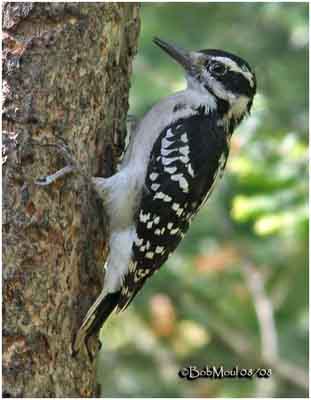
Female lays 3 to 6 glossy white eggs. Incubation lasts about two weeks, by both parents. Male broods at night and female during the day.
Chicks are fed by both adults. Young fledge at about one month, but they follow their parents during two weeks more, before to reach their independency.
This species produces only one clutch per season.
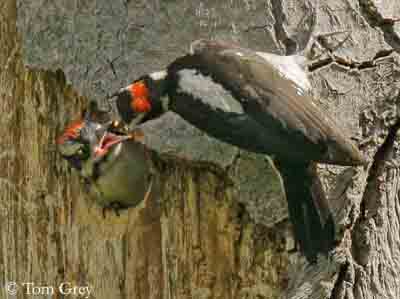
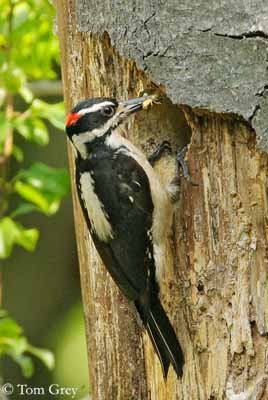
DIET:
Hairy Woodpecker feeds mainly on boring beetle larvae and insects. It also feeds on sap, berries, nuts, seeds and suet.
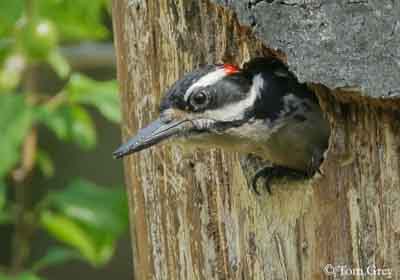
PROTECTION / THREATS / STATUS:
Populations of Hairy Woodpeckers are increasing in some areas. Protection of dense forests and retaining trees for nest cavities help these birds to maintain their numbers.
Fr: Pic chevelu
All : Haarspecht
Esp : Pico Velloso
Ital : Picchio villoso
Nd : Haarspecht
Sd : Harspett
Photographs by Tom Grey
His website : Tom Grey's Bird Pictures
Photographs by Bob Moul
His website : Nature Photography
Text by Nicole Bouglouan
Sources:
HANDBOOK OF THE BIRDS OF THE WORLD Vol. 7 by Josep del Hoyo-Andrew Elliott-Jordi Sargatal – Lynx Edicions – ISBN: 8487334377
FIELD GUIDE TO THE BIRDS OF NORTH AMERICA by National Geographic Society - National Geographic Society - ISBN: 0792274512
All About Birds (Cornell Lab of Ornithology)
Animal Diversity Web (University of Michigan Museum of Zoology)
What Bird-The ultimate Bird Guide (Mitchell Waite)
Wikipedia (Wikipedia, The Free Encyclopedia)
Bird Web (Seattle Audubon Society)